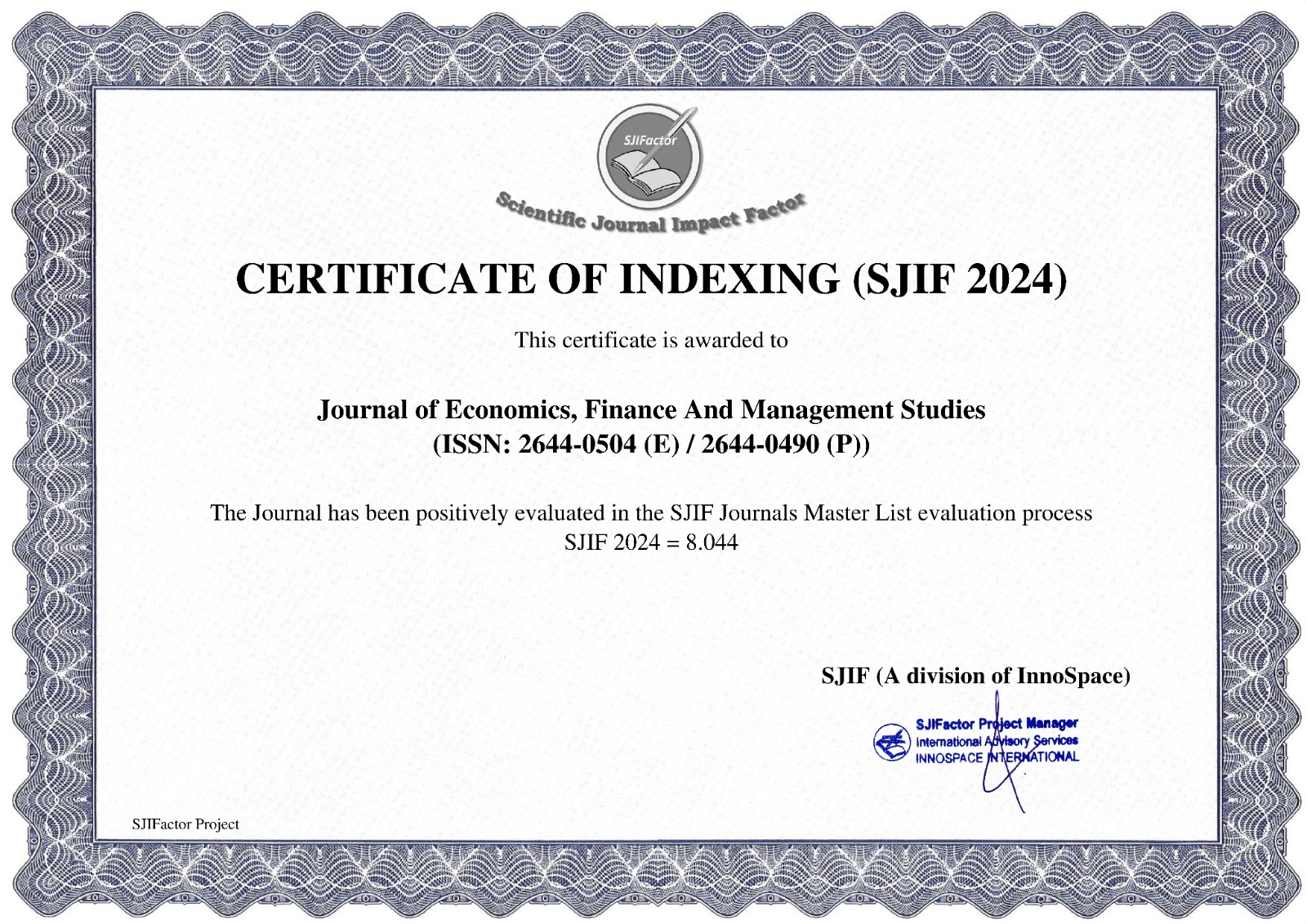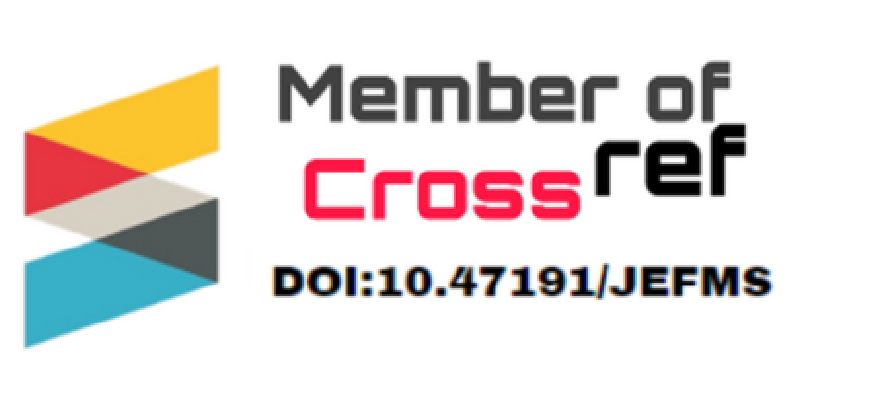Revealed Comparative Advantage and Sustainable Export Competitiveness of Firms in the East African Community
1Dr. Olyanga Anthony Moni, 2Mukundane Proscovia, 3Muhire Francis
1,2,3Faculty of Energy Economics and Management Sciences, Makerere University Business School
https://doi.org/10.47191/jefms/v8-i3-11ABSTRACT:
The purpose of this paper is to examine the influence of revealed comparative advantage as a determinant of the sustainability of export competitiveness of firms in the East African Community (EAC). The study adopted the Balassa’s measure of Revealed comparative advantage index model. The researcher computed the major trade outcome indicator of competitiveness on the data from 2003 to 2022. The study based on the top ten exports for each country to assess the competitiveness of a country`s overall basket of products as well as the specific sectors. Data was obtained from World Bank International Trade Centre (ITC) and World Bank development indicators. The results indicate that overall, the EAC countries have Revealed Comparative advantage in natural resource and primary products though the composition could be changing. The low RCA in other sectors reflect the lack of structural transformation which could explain a given considerable proportion of trade diversion and potential welfare losses in the EAC countries, reducing the sustainability of export competitiveness of firms in the foreign markets. Exporting countries need to take deeper reforms as regards structural transformation to enable firms to integrate into the Global Value Chains (GVCs) to enable them to increase their productivity by reviewing the existing policies to match the changes in the market. There is a need to examine the complicated nature of the EAC economy to further this study’s findings. This study explains the complex nature of the revealed comparative index as an indicator of sustainability of competitiveness in the EAC using quantitative data and that this complexity has an effect on the export competitiveness in import-oriented countries with less harmonization in their trade policies.
KEYWORDS:
Export competitiveness, Revealed Comparative Advantage index, East African Community.
REFERENCES:
1) Adriana, G. (2010). Globalisation and Export Competitiveness a Theoretical Approach. Annals of the University of Oradea: Economic Science, 1(1), 318–324.
2) AFDB. (2018). East Africa Economic Outlook 2018. https://www.afdb.org/fileadmin/uploads/afdb/Documents/Publications/2018AEO/African-Economic-Outlook-2018-East-Africa.pdf
3) Ahmed, G. (2012). Krugman Trade Theory and Developing Economies. China-USA Business Review, 11(12), 1557–1564. https://doi.org/10.17265/1537-1514/2012.12.002
4) Arvis, J.-F., Ojala, L., Wiederer, C., Shepherd, B., Raj, A., Dairabayeva, K., & Kiiski, T. (2018). Connecting to Compete: Trade Logistics in Global Economy; the Logistics Performance Index and its indicators. Connecting to Compete 2018. https://doi.org/10.1596/29971
5) Atkinson, R. D. (2013). Competitiveness, Innovation and Productivity: Clearing up the Confusion. The Information Technology & Innovation Foundation, August, 1–7.
6) Balassa, B., & Noland, M. (1989). “Revealed” Comparative Advantage in Japan and the United States. Journal of Economic Integration, 4(2), 8–15. ttps://doi.org/10.11130/jei.1989.4.2.8
7) Beyene, H. G. (2014). Trade Integration and Revealed Comparative Advantages of Sub-Saharan Africa and South Asian Merchandize Export. Foreign Trade Review, 49(2), 163–176. https://doi.org/10.1177/0015732514525170
8) Browne, S. (2011). Aid for Trade and Export Performance : a Business Perspective Aid for Trade Global Review.
9) EAC. (2016). Background to the East African Community (EAC) and key EAC statistics and trade data.
10) EAC. (2017). EAC Industrial Competitiveness Report 2017. EAC Industrial Competitiveness.
11) EAC (2020). East African Community Regional Trade Policy Study
12) Fassio, C. (2018). Export-led innovation: The role of export destinations. Industrial and Corporate Change, 27(1), 149–171 https://doi.org/10.1093/icc/dtx028
13) Gaglio, C. (2015). Measuring Country Competitiveness : A Survey of Exporting-based Indexes Measuring Country Competitiveness : A Survey of Exporting-based Indexes.
14) ITC. (2012). National Trade Policy for Export Success. In National Trade Policy for Export Success. https://doi.org/10.18356/5b9fbdcb-en
15) Jagdambe, S. (2019). Consistency Test of Revealed Comparative Advantage Index: Evidence from India’s Agricultural Export. Foreign Trade Review, 54(1), 16–28. https://doi.org/10.1177/0015732518810838
16) Justin. P & Rahul. D (2021).Three decades of export competitiveness literature: systematic review, synthesis and future research agenda; International Marketing Review Journal, Emerald Publishing Limited 0265-1335 DOI 10.1108/IMR-12-2020-0295
17) Katunze, M., & Kuteesa, A. (2016). Uganda’s Revealed Comparative Advantage in COMESA. Journal of Sustainable Development, 9(3), 192. https://doi.org/10.5539/jsd.v9n3p192
18) Krantz, Sebastian (2024) : Patterns of Global and Regional Integration in the East African Community, Kiel Working Paper, No. 2245, Kiel Institute for the World Economy (IfW Kiel), Kiel
19) Krugman, , Obstfeld, & Melitz, . (2012). International Economics: Theory and Policy; 9th edition (HarperColl).
20) Krugman, P. R. (1979). Increasing returns, Monopolistic Competition, and International Trade. 9, 469–479.
21) Kumar, Ranjit. (2014). Multicollinearity: causes, effects and remedies. 4405.
22) Latruffe, L. (2010). Competitiveness, Productivity and Efficiency in the Agricultural and Agri-Food Sectors. OECD Food, Agriculture and Fisheries Papers, 30(30), 1–63. https://doi.org/10.1787/5km91nkdt6d6-en
23) Li, J., & Lakzi, A. (2021), “A new model for assessing the role of IT-based systems, public policies and business intelligence on the export competitiveness’s efficiency”. Kybernetes. ahead-of-print. 10.1108/K-07-2020-0430.
24) Limão, N., & Venables, A. J. (2001). Infrastructure, geographical disadvantage, transport costs, and trade. 15(3), 451–479.
25) Makonnen, T. (2012). Determinants of Export Commodity Concentration and Trade Dynamics in Ethiopia. Ethiopian Economics Association Ethiopian Economics Policy Research Institute (EEA/EEPRI), 2(10), 1–19. https://doi.org/10.1007/s11837-012-0378-1
26) Melitz, M. J. (2003). The impact of trade on intra-industry reallocations and aggregate industry productivity. Econometrica, 71(6), 1695–1725. https://doi.org/10.1111/1468-0262.00467
27) Miteva-Kacarski, E. (2018). Revealed comparative advantage in trade between the Republic of Macedonia and Cefta 2006. Economic Review: Journal of Economics and Business, XVI(1). www.econstor.eu
28) Mkenda, B. K. (2022). Examining the Patterns and Dynamics of Intra-Regional Trade and Revealed Comparative Advantage in the East African Community. The African Review (published online ahead of print 2022). https://doi.org/10.1163/1821889x-bja10038
29) Pascucci, F. (2018), "The export competitiveness of Italian coffee roasting industry", British Food Journal, Vol. 120 No. 7, pp. 1529-1546.
30) Puertas, R., Mart, L. and Garc, L. (2014), “Logistics performance and export competitiveness: European experience,” Empirica, Vol. 41 No. 3, pp. 467-480.
31) Ruffin, R. J. (2015). The Nature and Significance of Intra-industry Trade. Economic and Financial Policy Review (Q IV) 2–9.
32) Sachitra, V., & Chong, S. (2015). Enhancing Competitive Advantage of Sri Lankan Minor Export Crops. Journal of Global Economics, Management and Business Research, 4(4), 185–194.
33) Schiff, M., & Winters, and L. A. (2003). Regional Integration and Development. In Planning Outlook (Vol. 24, Issue 2). https://doi.org/10.1080/00320718208711643
34) Siggel, E. (2007). International Competitiveness and Comparative Advantage: A Survey and a Proposal for Measurement. https://doi.org/10.2514/6.1986-1133
35) Sunanda, S. (2010). International Trade Theory and Policy : A Review of the Literature. 635.
36) The World Bank. (2016). Doing Business 2016: Measuring Regulatory Quality and Efficiency. In Doing Business 2016: Measuring Regulatory Quality and Efficiency. https://doi.org/10.1596/978-1-4648-0667-4
37) Umuhoza, A. and Wang, J. (2021) Research on EAC-China Economic Relations in Trade and Its Influences: An Analysis Based on Trade Intensities. Chinese Studies, 10, 100-122. doi: 10.4236/chnstd.2021.102008.
38) UNCTAD (2020), Key Statistics and Trends in International Trade 2020.
39) UNCTAD. (2013). Intra-African trade: Unlocking private sector Dynamism; Economic Development in Africa.
40) Utkulu, U., & Seymen, D. (2004). Revealed Comparative Advantage and Competitiveness : Evidence for Turkey vis-à-vis the EU / 15. September 2004, 1–26.
41) Venables, R. B. and A. (2011). Relocating the Value Chains, offshoring and Agglomeration in the Global Economy: Economics Series Working papers 554, University of Oxford. In National bureau of economic research (Vol. 1, Issue 4).
42) World Bank. (2016). Doing business: Measuring regulatory quality and efficiency. Economic Profile 2016. In Washington, DC: World Bank Group. (Issue DOI: 10.1596/978-1-4648-0667-4). https://doi.org/10.1596/978-1-4648-0667-4
















